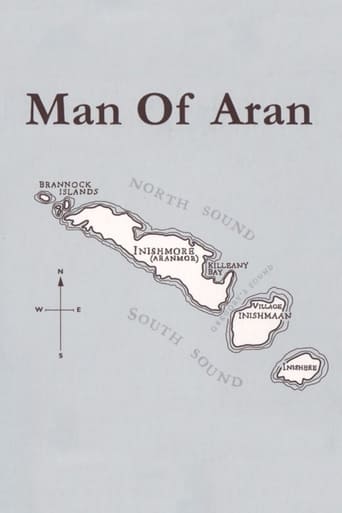forgottennmantra
This is a magnificent portrait not only of a dying way of life (dying in 1934 and still dying) but a portrait of the human struggle to find life in the most desolate of places. The photography is magnificent, the pacing is perfect and the piece transcends culture and even the very idea of "documentary" film. But this is true of all of Flaherty's films. Flaherty wasn't a documentarian. He didn't purport to be a disinterested observer (whatever that is). He staged his films, this has never been in dispute and he never made any attempts to hide the fact. He referred to films he made as "travel films", a phrase common in the 1930s. Make no mistake this film is a piece of art.
chris miller
both allmovie.com and imdb.com call this a documentary, but that's a bit iffy. it's real footage of real people, but the action is sorta directed and the people aren't portrayed as they are in real life - the three main characters are supposed to be related, but aren't really. it's more of a documentary than "kids," which is a feature film that is shot like a documentary and most of the actors weren't doing much acting - rather they were sort of just playing themselves. maybe it's a documentary like koyaanisqatsi (or man with a movie camera) is a documentary - things are distorted or shaped by the director, but it's still real life; tough to say. enough of that though, on to the review. the photography is much better in this film than it was in flaherty's first (nanook of the north, which i also own). the black and white images are much sharper and the cinematography is far more advanced. nanook of the north was sort of an accident film for flaherty - he was in northern canada on some sort of expedition and sort of fell into being a filmmaker. at any rate, this film is a definite step up (in a technical sense) from nanook of the north. he uses montage, at least a couple different cameras, and has gotten even better at editing, making this film truly good - especially for its time (1934). i mentioned a few reviews ago that 'triumph of the will' was hardly impressing, even when taking into account the year of release. here's a film that proves my point - it was released in the same year, it's also a documentary (mostly), and it's probably ten to eleven times better than 'triumph of the will.' B+.
Zen Bones
If you were to ask passers-by on the street if they'd be interested in seeing a 1934 documentary about the harsh day-to-day existence of a tiny community living on a remote island off the coast of Ireland -- well, you'd be standing there all day before you could find someone who'd say, "sure!". Which is really a disappointment because they don't know what they're missing!Think of every poem you've read about the sea and man's relation to it and you might get a clue as to the depths of feeling that this film has. It's like Hemingway, Pablo Neruda and W.B. Yeats all rolled into one. It's extremely simplistic, just shots of how a small family fishes, hauls seaweed for fertilizer (there is no soil on the island) and dodges waves so high that its foam sprays above the cliff-tops. Not to mention an incredible sequence where five fishermen try to catch and kill a shark that is a good deal larger than their boat!What's most exhilarating about this film is that while you're watching it, you can't help but think that these people are crazy to choose to live in such a desolate and difficult place, but then you try to imagine them elsewhere and you know that they are as much a part of that environment as the stubborn sea-worn cliffs are. After even thirty minutes of the film, the roar of the ocean and the cries of the gulls fill your head to such an extreme that you know that such people could live no where else. This film is reminiscent of Roberto Rossellini's film, "Stromboli" about the inhabitants of a small village on a volcanic island. There are a few brief pockets of sentimentality due to the score, but the filmmakers thankfully left out the music during all of the film's most important scenes. Overall what you have is an incredible cinematic experience that makes you think and imagine what it would be like to live a life where every day is a struggle with the elements of nature and a fight for survival, yet filled with the deepest awe and respect for nature and for living.
Glaschu
An amazing document and well worth seeing.It is strange to watch a classic documentary film on this brave community and not get a single chance to hear them speak one word in their own language (Irish Gaelic). The voice-overs were all in English, for the audience of course. But we would not have been harmed by even a smattering of dialog in Irish.I also missed seeing a little more of domestic life. What did they eat, how did they cook, what was their religious life like? We see only the sea, the source of their existence, but not much of what they did beyond it.


